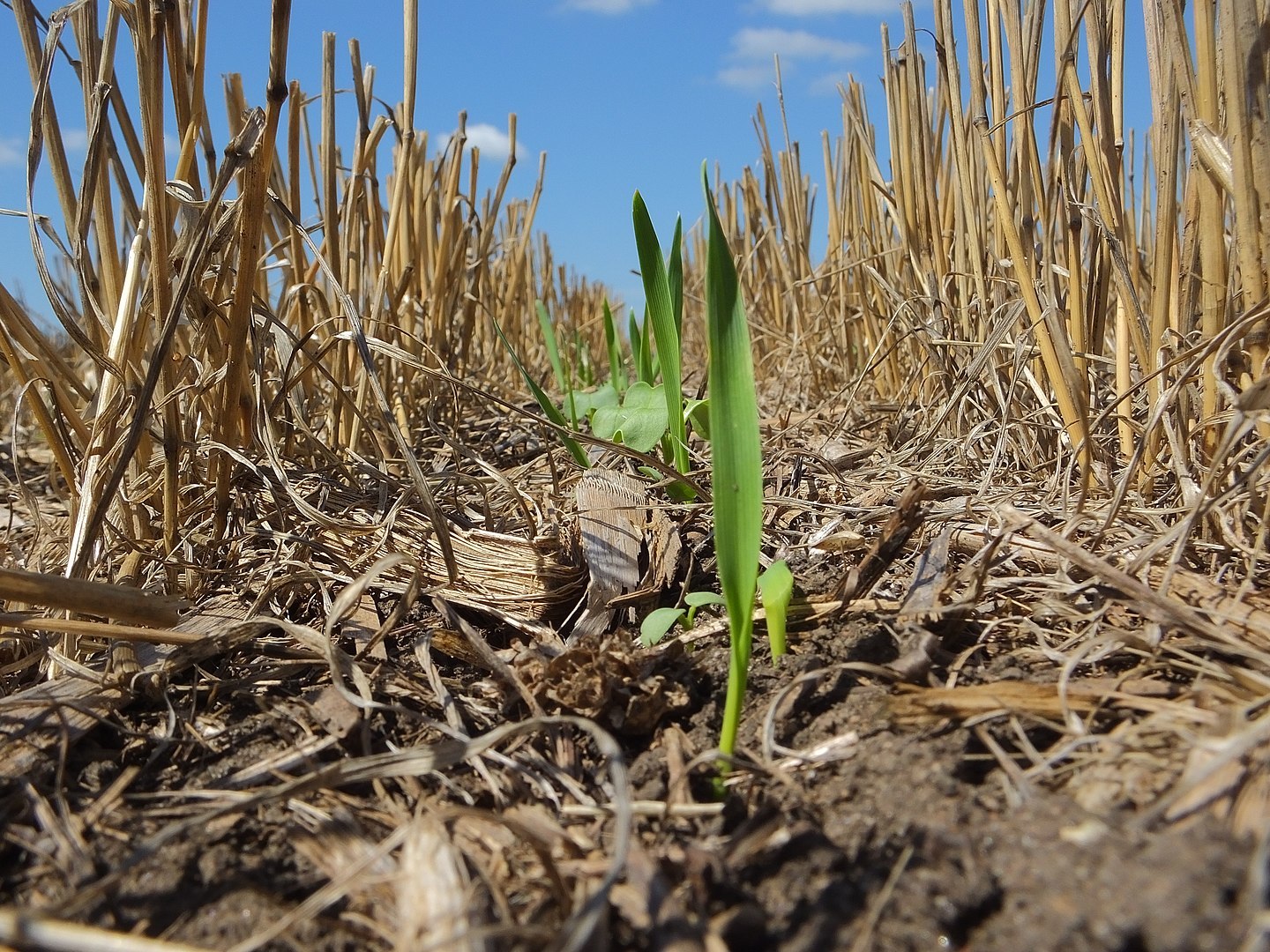To Cut Nitrogen Pollution, Move Past the Synthetic-Organic Debate
There's No Silver Bullet Solution
-
-
Share
-
Share via Twitter -
Share via Facebook -
Share via Email
-
Modern farming feeds billions of people, in large part thanks to easily available nitrogen fertilizer. Nitrogen is an essential nutrient for all plants. A small number of plants, such as the legumes soy and clover, can get most of their nitrogen from the air. But most crops require people to add some type of nitrogen fertilizer. As we wrote about in an earlier essay, the majority of this nitrogen fertilizer used today — billions of pounds of it — is synthetic, manufactured in industrial facilities.1
Unfortunately, nitrogen also contributes to many of today’s greatest environmental challenges. Most nitrogen that is applied to crops — as much as 58% according to one recent estimate — escapes from farms and pollutes the environment.2 There is now about twice as much nitrogen cycling through cropland, forests, oceans and the rest of the environment than in pre-industrial times.3 Some of the nitrogen is emitted as nitrous oxide, a potent greenhouse gas responsible for nearly 50% of agriculture’s greenhouse gas emissions in the US.4 And some nitrogen flows off farms into water bodies in a process known as nitrate leaching. Too much nitrogen in water can threaten human health and lead to eutrophication, an overload of nutrients that causes algal blooms and kills off marine life, as has happened in the Gulf of Mexico.5
To address eutrophication and greenhouse gas emissions from fertilizer use, some advocate for expanding the use of organic farming. Organic farms don’t use any synthetic fertilizer. Instead they largely rely on manure, nitrogen-fixing legumes, and compost for nitrogen. But do these organic fertilizers actually address the environmental problems that advocates hope to solve?
In short, the answer is no. Organic fertilizers are far from a silver bullet when it comes to both eutrophication and greenhouse gas emissions. But that doesn’t mean that synthetic fertilizers alone are the answer either.
Arguing about whether organic or synthetic fertilizers are better for the environment is largely a dead end. Instead, the solution lies in getting past the unproductive organic-synthetic debate and focusing on measures to increase the efficiency of all fertilizers and to reduce nitrogen losses.
Reason 1: Organic Fertilizers Are a Mixed Bag
Among the reasons why the organic-synthetic debate is unproductive is that organic fertilizers are a decidedly mixed bag, which makes any evaluation of them as a package misleading and unhelpful. To understand why, let’s consider the two main organic fertilizers: manure and legumes.
Compared to synthetic fertilizer, manure is often more polluting. Farmers who use manure in the U.S. lose 46-72% more nitrogen (~10-20 more lbs) per acre to the environment than farmers not using manure. Most of this nitrogen pollution enters waterways, contributing to eutrophication.6,7
The main reason manure has such large eutrophication impacts is that farmers need to use a lot of it to fertilize their crops.8 For example, U.S. farmers using manure apply 40-50 more lbs/acre of nitrogen than other farmers.9 The more nitrogen they add, the more leaches through the soil into groundwater or flows into rivers and streams.10,11
But why would farmers apply so much manure if they’re trying to be stewards of the environment? The answer lies not in the actions of farmers, but in the manure itself.
Plants simply can’t use much of the nitrogen contained in most types of manure, leading to large nitrogen losses. For example, plants can only use 50-80% as much of the nitrogen from beef cattle manure as from synthetic fertilizer.12 One reason is that the nitrogen in manure is slowly released over many years, and often when plants don’t need it.13Another reason is that all types of manure, even liquid manure, can be challenging to spread across a field uniformly so that every plant gets the same nitrogen dosage.14 As a result, many farmers apply excess manure to ensure that all their crops are properly fertilized.15
The practicalities of transporting manure also lead many animal producers to simply apply their manure supply to nearby cropland, which leads to high application rates, nitrogen losses, and eutrophication. Manure can contain over 100 times less nitrogen per pound than synthetic fertilizer, making it prohibitively heavy and expensive to move more than several miles.16 In addition, more and more livestock production occurs in places without enough cropland nearby to apply manure to. This means that farmers need to transport manure farther to apply it to cropland that can absorb it — a further disincentive to applying it at proper rates.17,18
What about greenhouse gas emissions? Is manure worse than synthetic fertilizer in this regard too? The primary driver of nitrous oxide emissions is the amount of nitrogen applied.19,20,21,22 Since using manure involves applying more nitrogen to get the same crop yield (compared to synthetic fertilizer), it typically results in greater nitrous oxide emissions per unit of food produced.
Still, when we consider the big picture, synthetic fertilizer use is about as greenhouse gas–intensive as manure. Manufacturing synthetic fertilizer uses large amounts of natural gas. Even some of the most efficient fertilizer factories emit 2–4 tons of carbon dioxide–equivalent for each ton of nitrogen fertilizer produced.23 It may be feasible one day to use clean energy sources to make fertilizer and therefore cut emissions. But when emissions from manufacturing and application are both considered, food grown with synthetic fertilizer and manure currently have similar levels of emissions.24,25,26
In other words, manure, compared to synthetic nitrogen, tends to increase eutrophication while emitting similar levels of greenhouse gases. If organic farmers relied exclusively on manure as fertilizer, eutrophication would likely worsen and pose a clear environmental threat. But because organic also encapsulates green manures, the picture is more complex. Green manures are legumes (plants that “fix” much of their own nitrogen from the atmosphere) that farmers grow and then till into the soil, providing nutrients to future crops.27 Using green manures is a common practice among organic farmers, with nearly ¾ of European organic farmers reporting use.28

Using green manures does modestly increase some types of greenhouse gas emissions. By adding nitrogen to the soil, green manure crops increase nitrous oxide emissions in many circumstances.29 Farmers also need to burn more fuel operating their machinery to plant and manage the crops.30
But the extra nitrous oxide emissions from green manures are far outweighed by their benefits. Using green manures reduces the amount of other fertilizers farmers must apply to future crops, and enhances carbon sequestration.31 Overall, this makes them carbon-negative. In addition, planting green manure crops generally reduces nitrate leaching from soil and often increases yields.32,33
Given the wide use of animal manure and green manure on organic farms, it makes little sense to compare organic and synthetic fertilizers as monolithic categories. Manure disproportionately contributes to eutrophication while green manures provide clear benefits.
Reason 2: Manure Isn't Going Anywhere
Another reason that debates about organic and synthetic fertilizers are unproductive is that they rarely provide clear guidance on how to actually reduce agriculture’s impacts. Though manure has environmental downsides, we can’t just get rid of it. As long as people continue consuming animal products, there is no avoiding manure. Wherever there is confined livestock, dairy or other animal production, there is loads of manure and and all of it must be managed.
In fact, buying manure and using it as commercial fertilizer is likely better than the alternative, which is for producers to spread the manure on their own land. As we mentioned, animal producers typically have a limited amount of land, and so they often apply it at higher than recommended rates, leading to significant nitrogen losses. By contrast, when farmers buy manure from livestock producers, they help offload the excess manure and thereby reduce overapplication.34 So eschewing commercial manure just because it has environmental downsides would be a poor environmental option.
Reason 3: Nothing Can Plausibly Replace Synthetic Fertilizer
Similarly, even if synthetic fertilizers were worse in some ways, we can’t simply replace them. If all the manure produced throughout the U.S. were applied to farmland, it wouldn’t even replace half the synthetic fertilizer that is used today.35 And in reality, it would replace far less since much of the manure is excreted by animals on pasture and rangelands where it can’t be collected and later used as fertilizer.36
Green manure, compost, and other sources of organic fertilizer also couldn’t replace all the synthetic fertilizer. Green manures may provide many benefits, but as we have written previously, they could only replace a fraction of today’s synthetic fertilizer use — no more than 38% under the very best imaginable scenario and likely much less.
It’s certainly possible that new innovations in fertilizer technology, such as microbial treatments and soil amendments, will someday replace the current variety of synthetic fertilizer we have. But for now, synthetic fertilizer is here to stay.
Because neither manure nor synthetic fertilizer are going away any time soon, it makes little sense to pursue a vision for the future of agriculture that rests on the supposed superiority of one type of fertilizer over another. The problem lies not so much in the type of fertilizer we use, but in how we use it.
The Right Question: How to Use Less Fertilizer and Minimize Losses
Recognizing that organic-synthetic comparisons don’t paint a clear path forward should encourage us to focus on broader ways to reduce nitrogen pollution from all types of fertilizer. Using less fertilizer and minimizing losses may not sound like a revolutionary or inspiring solution, but research indicates the benefits could be vast.
In many regions of the world, such as in parts of China and the American Midwest, farmers can reduce synthetic fertilizer application while maintaining or even improving yields.37 In some cases, providing farmers with more tailored advice on farm management practices and how much fertilizer to apply can make a large difference. For example, a recent initiative in China helped millions of small farmers reduce their nitrogen use about 15% while also increasing yields.38
Farmers can also reduce nitrogen use by adopting precision farming equipment that helps them apply just the right amount of fertilizer to their crops. These technologies include soil nutrient sensors, tractors with GPS and auto-steering, and machines that vary how much fertilizer they apply. Many farmers have adopted several of these practices, but not all. For example, U.S. farmers have quickly adopted auto-steering tractors that can vary how much fertilizer they apply, but have been slow to experiment with nutrient sensors and newer precision technologies, illustrating that there is still much room for improvement.39
There are many opportunities to reduce nitrogen losses from manure as well, particularly through increasing the use of waste-to-energy systems such as anaerobic digesters.40,41 Anaerobic digesters convert methane gas from manure into electricity, cutting emissions both from manure storage and energy use. Moreover, farmers can use the byproduct from electricity production, which is more nutrient-dense than raw manure, making it easier to transport and apply at recommended rates.42,43,44
Composting manure can also reduce nitrogen losses and greenhouse gas emissions.45,46 Composting involves piling manure in rows or heaps, mixing it with other materials, and aerating it to accelerate the process of decomposition.47 This directly reduces nitrogen losses as well as concentrates the nutrients in manure, making it cost-effective to transport farther and apply at proper levels.48
Additionally, though manure is more difficult to apply precisely, it can be applied more efficiently.49 For instance, farmers can use specially designed tractors to inject manure below the soil surface or use irrigation systems to deliver manure to crops’ root zones.50 These two methods not only cut manure losses, emissions, and leaching, but also enable farmers to provide more nitrogen to crops with the same amount of manure, thereby reducing the need for other fertilizers.51
As many environmental groups note, shifting animal production closer to cropland could also reduce nitrogen losses from manure.52 Currently, nearly 300 counties in the U.S. have animal feeding operations that produce more manure than all the cropland in the county can absorb.53 There are reasons why this is the case — high degrees of specialization can generate economies of scale. Nevertheless, policies that incentivize livestock producers to own more cropland to spread manure on or to open facilities near areas of high crop production could have real environmental benefits.54,55
Finally, changes in land management can also substantially reduce all types of nitrogen losses, whether from synthetic fertilizer or manure. For example, growing plants along the edges of fields (e.g. buffer strips) can suck up excess nitrogen, and practices like no-till farming can reduce soil erosion, which also contributes to nitrogen water pollution.56
Moving Forward: Incentivizing Change
In short, while we may be stuck with manure and synthetic fertilizer, we’re not stuck with the extent of their environmental impacts. There are many options farmers and livestock producers have to reduce nitrogen losses, water pollution, and greenhouse gas emissions. The problem is not a lack of good solutions, but a lack of incentives. Installing anaerobic digesters or adopting manure injection systems is expensive and requires new types of technical expertise. To truly cut nitrogen pollution, we need government and market incentives for producers to adopt best practices and for researchers to bring the costs down. These incentives may take a number of forms: subsidies, government-sponsored farmer outreach (or “extension”), pollution taxes and regulation, and more.
There is a wide array of promising pathways for reducing pollution from agriculture, but simply replacing synthetic fertilizer is not one of them.
Lassaletta, L., Billen, G., Garnier, J., Bouwman, L., Velazquez, E., Mueller, N. D., & Gerber, J. S. (2016). Nitrogen use in the global food system: past trends and future trajectories of agronomic performance, pollution, trade, and dietary demand.Environmental Research Letters, 11(9), 95007. doi.org/10.1088/1748-9326/11/9/095007. p. 1 and 6.
Zhang, X., Davidson, E. A., Mauzerall, D. L., Searchinger, T. D., Dumas, P., & Shen, Y. (2015). Managing nitrogen for sustainable development. Nature, 528(7580), 51. p.5 Table 1 Note: The nitrogen use efficiency (NUE) of 0.42 corresponds to a loss of 58% of the nitrogen inputs.
Fowler, D., Coyle, M., Skiba, U., Sutton, M. A., Cape, J. N., Reis, S., ... & Vitousek, P. (2013). The global nitrogen cycle in the twenty-first century. Phil. Trans. R. Soc. B, 368(1621), 20130164. p. 2 Calculation: X Teragrams of current N estimated in Lassaletta et al. (2016)
Calculation: 251 MtCO2e from agricultural soil management / 522.3 MtCO2e total from agricultural sector. (2017). Inventory of US greenhouse gas emissions and sinks: 1990-2015: Chapter 5. Environmental Protection Agency.https://www.epa.gov/sites/production/files/2017-02/documents/2017_chapter_5_agriculture.pdf p. 5-1
Robertson, G. P., Vitousek, P. M., & Kellogg, W. K. (2009). Nitrogen in Agriculture: Balancing the Cost of an Essential Resource. Annual Review of Environment and Resources, 34(1), 97–125. doi.org/10.1146/annurev.environ.032108.105046. p. 103.
The first number is calculated using the median values, the second using the mean. U.S. Department of Agriculture, Natural Resources Conservation Service. 2017. Effects of Conservation Practices on Nitrogen Loss from Farm Fields: A National Assessment Based on the 2003-06 CEAP Survey and APEX Modeling Databases.www.nrcs.usda.gov/Internet/FSE_DOCUMENTS/nrcseprd1365657.pdf, p. 48
But see contrary finding of lower eutrophication potential per unit area on organic farms from Tuomisto, H. L., Hodge, I. D., Riordan, P., & Macdonald, D. W. (2012). Does organic farming reduce environmental impacts?--a meta-analysis of European research. Journal of Environmental Management, 112(834), 309–20. doi.org/10.1016/j.jenvman.2012.08.018, p. 314
"...farmers often apply manure N at rates much higher than they would apply fertilizer N to achieve similar total plant-available N." Han, Z., Walter, M. T., & Drinkwater, L. E. (2017). N2O emissions from grain cropping systems: a meta-analysis of the impacts of fertilizer-based and ecologically-based nutrient management strategies. p. 345
U.S. Department of Agriculture, Natural Resources Conservation Service. 2017. Effects of Conservation Practices on Nitrogen Loss from Farm Fields: A National Assessment Based on the 2003-06 CEAP Survey and APEX Modeling Databases.www.nrcs.usda.gov/Internet/FSE_DOCUMENTS/nrcseprd1365657.pdf, p. 48. Note: This is the difference between “Nitrogen applied as commercial fertilizer and manure,” omitting N from biological fixation or deposition.
“We found that N fertilizer rate had the most significant impact on N2O emissions...this relationship between the quantity of N applied and N2O emissions is congruent with studies linking N rates to the size of soil inorganic N pools, nitrate leaching and total N losses.” Boy- Roura et al. 2016 in Han, Z., Walter, M. T., & Drinkwater, L. E. (2017). N2O emissions from grain cropping systems: a meta-analysis of the impacts of fertilizer-based and ecologically-based nutrient management strategies. Nutrient Cycling in Agroecosystems, 107(3), 335–355. doi.org/10.1007/s10705-017-9836-z, p. 343
Leaching and runoff rates are similar for manure and synthetic fertilizer, estimated at 12-17% of applied nitrogen over 80 years: Sebilo, M., Mayer, B., Nicolardot, B., Pinay, G., & Mariotti, A. (2013). Long-term fate of nitrate fertilizer in agricultural soils. Proceedings of the National Academy of Sciences, 110(45), 18185-18189. See also the higher estimate of ~20% from Millennium Ecosystem Assessment (MA). 2005. Ecosystems and Human Wellbeing: Policy Responses Volume 3. Chapter 9: Nutrient Management: pp. 295-311 in www.wri.org/our-work/project/eutrophication-and-hypoxia/sources-eutrophication
Webb, J., Sørensen, P., Velthof, G., Amon, B., Pinto, M., Rodhe, L., … Reid, J. (2013). An Assessment of the Variation of Manure Nitrogen Efficiency throughout Europe and an Appraisal of Means to Increase Manure-N Efficiency. In Advances in Agronomy (Vol. 119, pp. 371–442), p. 390
Ibid.
Sawyer, J. (2007). Is Manure the Same as Fertilizer as a Crop Nutrient Resource? p.2
Lassaletta et al.
Lory, J. A., & Massey, R. (2006). Using Manure as a Fertilizer for Crop Production. In Mississippi Basin Symposia. Retrieved from https://www.epa.gov/sites/production/files/2015-07/documents/2006_8_25_msbasin_symposia_ia_session8.pdf, p. 3
Ibid.
e.g. MacDonald, James M. Manure use for fertilizer and for energy: report to congress. DIANE Publishing, 2009.
“...the quantity of N added was a more significant driver of N2O fluxes than was the form of N.” Han, Z., Walter, M. T., & Drinkwater, L. E. (2017). p. 335
Sainju, U. M. (2016). A global meta-analysis on the impact of management practices on net global warming potential and greenhouse gas intensity from cropland soils. PloS one, 11(2), e0148527 p. 1
Stehfest, E., & Bouwman, L. (2006). N2O and NO emission from agricultural fields and soils under natural vegetation: summarizing available measurement data and modeling of global annual emissions. Nutrient Cycling in Agroecosystems, 74(3), 207–228. doi.org/10.1007/s10705-006-9000-7. p. 207, 211
But note that a smaller portion of the nitrogen in manure than in most synthetic fertilizers is emitted as nitrous oxide. Davidson, E. A. (2009). The contribution of manure and fertilizer nitrogen to atmospheric nitrous oxide since 1860. Nature Geoscience, 2(9), 659-662.
These values are for tons of CO2e per ton Nitrogen contained in the fertilizer for the average facility in Europe. Stork, M., & Bourgault, C. (2015). Fertilizers and Climate Change. Retrieved fromwww.fertilizerseurope.com/fileadmin/documents/ETS/1._Fertilizers_Europe_documents/Ecofys_Fertilizers_and_Climate_Change_FinalReport21092015_b.pdf
Clark, M., & Tilman, D. (2017). Comparative analysis of environmental impacts of agricultural production systems, agricultural input efficiency, and food choice. Environmental Research Letters, 12(6), 64016. https://doi.org/10.1088/1748-9326/aa6cd5, p. 4
Tuomisto et al. (2012). p. 314
This can be demonstrated through calculations of average values as well. Default emission factors for synthetic N fertiliser is 0.01 kg N2O-N/kg N for direct N2O emission, 0.01 kg N2O-N/kg for indirect N2O emission from volatilization and 0.0075 kg N2O-N/kg N for indirect leached/runoff emissions (IPCC, 2006). Assuming the fraction of synthetic N fertiliser volatised is 0.1 and the fraction of synthetic N fertiliser leached/runoff is 0.3, gives us 0.01325 kg N2O-N/kg N total. N2O-N emissions are typically converted to N2O using a multiplier of 44/28 and then converted to CO2-eq by multiplying them with a global warming potential of 298. This gives us a final CO2-eq value of 6.205 kg CO2/kg N, although it should be noted that N2O emissions have been observed to increase exponentially with application rates. Adding the 2-4 kg CO2/kg N from manufacturing would increase emissions by ~33-50%.
e.g. Baggs, Watson, & Rees, 2000, p. 154
Peigné, J., Casagrande, M., Payet, V., David, C., Sans, F. X., Blanco-Moreno, J. M., ... & Bigongiali, F. (2016). How organic farmers practice conservation agriculture in Europe. Renewable Agriculture and Food Systems, 31(1), 72-85. Abstract.
Basche, A. D., Miguez, F. E., Kaspar, T. C., & Castellano, M. J. (2014). Do cover crops increase or decrease nitrous oxide emissions? A meta-analysis. Journal of Soil and Water Conservation, 69(6), 471-482. Abstract
Kaye, J. P., & Quemada, M. (2017). Using cover crops to mitigate and adapt to climate change. A review. Agronomy for Sustainable Development, 37(1), 4. doi.org/10.1007/s13593-016-0410-x p. 9
Ibid, p. 5
Han, Z., Walter, M. T., & Drinkwater, L. E. (2017). N2O emissions from grain cropping systems: a meta-analysis of the impacts of fertilizer-based and ecologically-based nutrient management strategies. Nutrient Cycling in Agroecosystems, 107(3), 335–355. https://doi.org/10.1007/s10705-017-9836-z p. 350-351
Lory, J. A., & Massey, R. (2006). Using Manure as a Fertilizer for Crop Production. In Mississippi Basin Symposia. Retrieved from https://www.epa.gov/sites/production/files/2015-07/documents/2006_8_25_msbasin_symposia_ia_session8.pdf, p. 3
Manure N to fertilizer ratio 1970-2012 was 0.50–0.77, with the ratio decreasing over time. Therefore, manure amounted to 33 - 43% of total manure available. Calculation: Percent of total = ratio / (1 ratio). Yang, Q., Tian, H., Li, X., Ren, W., Zhang, B., Zhang, X., & Wolf, J. (2016). Spatiotemporal patterns of livestock manure nutrient production in the conterminous United States from 1930 to 2012. Science of the Total Environment, 541, 1592-1602, p. 1594
Mueller, N. D., Gerber, J. S., Johnston, M., Ray, D. K., Ramankutty, N., & Foley, J. A. (2012). Closing yield gaps through nutrient and water management. Nature, 490, 254–257. doi.org/10.1038/nature11420, p. 2
Cui, Z., Zhang, H., Chen, X., Zhang, C., Ma, W., Huang, C., … Dou, Z. (2018). Pursuing sustainable productivity with millions of smallholder farmers. Nature. Retrieved from dx.doi.org/10.1038/nature25785
http://www.croplife.com/equipment/2017-precision-dealership-survey-making-the-turn-toward-decision-agriculture/Fig. 1, statistics for UAVs
Less than 5% of operations in the U.S. currently use anaerobic digesters. 250 anaerobic digester projects out of 8,000 hog and dairy operations EPA estimates could technically install a system. https://www.epa.gov/agstar/agstar-data-and-trends
Pape, D., Lewandrowski, J., Steele, R., Man, D., Riley-Gilbert, M., Moffroid, K., … Moffroid, K. (2016). Managing Agricultural Land for Greenhouse Gas Mitigation within the United States. Retrieved fromhttps://www.usda.gov/oce/climate_change/White_Paper_WEB_Final_v3.pdf, p. 18
This process still produces product that can be used as fertilizer. http://articles.extension.org/pages/30310/uses-of-solids-and-by-products-of-anaerobic-digestion
Gorrie, Peter (August 2014) Capitalizing On Digester Coproducts. BioCycle. Accesed 11/29/17https://www.biocycle.net/2014/08/13/capitalizing-on-digester-coproducts/
Recommended rates may need to be different for leachate, however, given that nutrients in digestate (the byproduct) are more prone to runoff and leaching when applied than those in manure.
Compost: Enhancing the Value of Manure. An assessment of the environmental, economic, regulatory, and policy opportunities of increasing the market for manure compost. (2017). Retrieved from http://suscon.org/wp-content/uploads/2017/10/Sustainable-Conservation_Manure-Compost-Report.pdf, p. 16
Ibid., p. 19.
Compost: Enhancing the Value of Manure, p. 15.
Gaskell, M., & Smith, R. (2007). Nitrogen Sources for Organic Vegetable Crops, 4461(December), 431–441
Liquid Manure Injection. (2015). (Agronomy Fact Sheet Series No. 87). Retrieved fromhttp://nmsp.cals.cornell.edu/publications/factsheets/factsheet87.pdf, p. 1-2
e.g. MacDonald, J. M. (2009)
Yang, Q., Tian, H., Li, X., Ren, W., Zhang, B., Zhang, X., & Wolf, J. (2016). Spatiotemporal patterns of livestock manure nutrient production in the conterminous United States from 1930 to 2012. Science of the Total Environment, 541, 1592-1602, p. 1598
Hilimire, K. (2011). Integrated crop/livestock agriculture in the United States: A review. Journal of Sustainable Agriculture, 35(4), 376-393. p. 382-384. http://www.tandfonline.com/doi/abs/10.1080/10440046.2011.562042
MacDonald, J. M. (2009).
Ribaudo M, Marshall E, Aillery M, Scott S (2016) Reducing the dead zone in the Gulf of Mexico: Assessing the costs to agriculture. Selected Paper Prepared for Presentation at the 2016 Agricultural & Applied Economics Association Annual Meeting, Boston, MA, July 31–August 2. http://ageconsearch.umn.edu/record/235197/files/Seclectedpaper_2016c.pdf, p. 11










